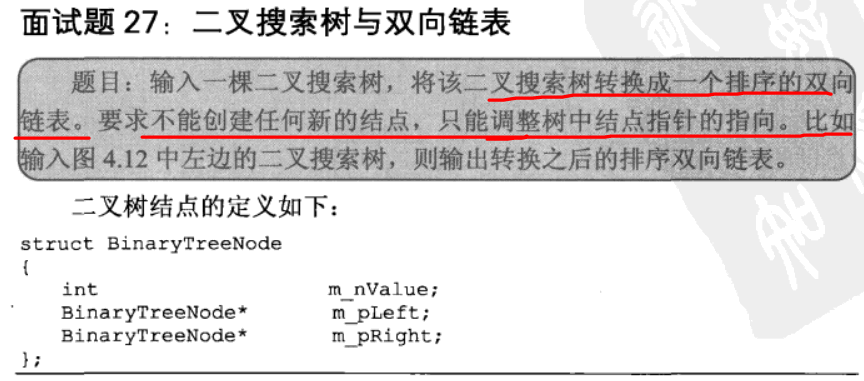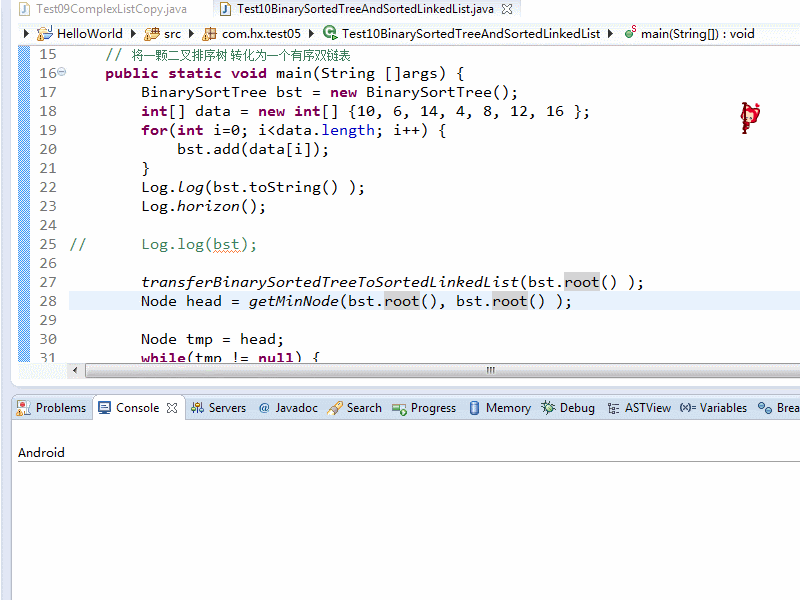17 将二叉排序树转换为有序双链表
2016-01-12 21:11
351 查看
前言
本博文部分图片, 思路来自于剑指offer 或者编程珠玑问题描述

思路
思路 : 因为要将二叉排序树更新各个结点的引用更新为一个有序双链表, 所以必然需要将左子树的最大结点 和根节点和 右子树的最小结点连在一起, 这样的话将左右子树看成一个整体, 整个链表就变成了”左子树 - 根节点 - 右子树”, 有序, 然后对于左右子树递归处理参考代码
/**
* file name : Test10BinarySortedTreeAndSortedLinkedList.java
* created at : 5:36:06 PM Jun 7, 2015
* created by 970655147
*/
package com.hx.test05;
import com.hx.test04.Test17BinarySortTree.BinarySortTree;
import com.hx.test04.Test17BinarySortTree.Node;
import com.hx.util.Log;
public class Test10BinarySortedTreeAndSortedLinkedList {
// 将一颗二叉排序树 转化为一个有序双链表
public static void main(String []args) {
BinarySortTree bst = new BinarySortTree();
int[] data = new int[] {10, 6, 14, 4, 8, 12, 16 };
for(int i=0; i<data.length; i++) {
bst.add(data[i]);
}
Log.log(bst.toString() );
Log.horizon();
// Log.log(bst);
transferBinarySortedTreeToSortedLinkedList(bst.root() );
Node head = getMinNode(bst.root(), bst.root() );
Node tmp = head;
while(tmp != null) {
Log.log(tmp);
tmp = tmp.getRight();
}
Log.horizon();
}
// 先更新各个结点的指向
// 最后 特殊处理 max.right, min.left
public static void transferBinarySortedTreeToSortedLinkedList(Node node) {
transferBinarySortedTreeToSortedLinkedList0(node);
getMaxNode(node, node).setRight(null);
getMinNode(node, node).setLeft(null);
}
// 思路 : 获取node左边的最大的结点, 以及node右边的最小的结点
// 设置这三个结点的关系, node.left = leftMax, node.right = rightMin, leftMax.right = node, rightMin.left = node
// 如果leftMax 不为left 则递归transferBinarySortedTreeToSortedLinkedList0
// 如果rightMax 不为right 则递归transferBinarySortedTreeToSortedLinkedList0
private static void transferBinarySortedTreeToSortedLinkedList0(Node node) {
if(node == null) {
return ;
}
Node left = node.getLeft(), right = node.getRight();
Node leftMax = getMaxNode(node.getLeft(), node);
Node rightMin = getMinNode(node.getRight(), node);
node.setLeft(leftMax);
if(leftMax != null) {
leftMax.setRight(node);
}
node.setRight(rightMin);
if(rightMin != null) {
rightMin.setLeft(node);
}
if((left != null) && (left != leftMax) ) {
transferBinarySortedTreeToSortedLinkedList0(left);
}
if((right != null) && (right != rightMin) ) {
transferBinarySortedTreeToSortedLinkedList0(right);
}
}
// 获取node节点下最小的结点 并且不能小于unexpected
private static Node getMinNode(Node node, Node unexpected) {
if(node == null) {
return null;
}
Node tmp = node;
while(tmp.getLeft() != null && tmp.getLeft() != unexpected) {
tmp = tmp.getLeft();
}
return tmp;
}
// 获取node节点下 最大的结点 并且不能超过unexpected
private static Node getMaxNode(Node node, Node unexpected) {
if(node == null) {
return null;
}
Node tmp = node;
while(tmp.getRight() != null && tmp.getRight() != unexpected) {
tmp = tmp.getRight();
}
return tmp;
}
}效果截图

总结
再一次巧妙的利用了递归。。注 : 因为作者的水平有限,必然可能出现一些bug, 所以请大家指出!
相关文章推荐
- java对世界各个时区(TimeZone)的通用转换处理方法(转载)
- java-注解annotation
- java-模拟tomcat服务器
- java-用HttpURLConnection发送Http请求.
- java-WEB中的监听器Lisener
- Android IPC进程间通讯机制
- Android Native 绘图方法
- Android java 与 javascript互访(相互调用)的方法例子
- 介绍一款信息管理系统的开源框架---jeecg
- 聚类算法之kmeans算法java版本
- java实现 PageRank算法
- PropertyChangeListener简单理解
- [C/C++]反转链表
- c++11 + SDL2 + ffmpeg +OpenAL + java = Android播放器
- 插入排序
- 冒泡排序
- 堆排序
- 快速排序
